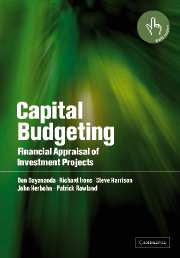Book contents
- Frontmatter
- Contents
- List of figures
- List of tables
- Preface
- 1 Capital budgeting: an overview
- 2 Project cash flows
- 3 Forecasting cash flows: quantitative techniques and routes
- 4 Forecasting cash flows: qualitative or judgemental techniques
- 5 Essential formulae in project appraisal
- 6 Project analysis under certainty
- 7 Project analysis under risk
- 8 Sensitivity and break-even analysis
- 9 Simulation concepts and methods
- 10 Case study in financial modelling and simulation of a forestry investment
- 11 Resource constraints and linear programming
- 12 More advanced linear programming concepts and methods
- 13 Financial modelling case study in forestry project evaluation
- 14 Property investment analysis
- 15 Forecasting and analysing risks in property investments
- 16 Multinational corporations and international project appraisal
- References
- Index
13 - Financial modelling case study in forestry project evaluation
Published online by Cambridge University Press: 14 May 2010
- Frontmatter
- Contents
- List of figures
- List of tables
- Preface
- 1 Capital budgeting: an overview
- 2 Project cash flows
- 3 Forecasting cash flows: quantitative techniques and routes
- 4 Forecasting cash flows: qualitative or judgemental techniques
- 5 Essential formulae in project appraisal
- 6 Project analysis under certainty
- 7 Project analysis under risk
- 8 Sensitivity and break-even analysis
- 9 Simulation concepts and methods
- 10 Case study in financial modelling and simulation of a forestry investment
- 11 Resource constraints and linear programming
- 12 More advanced linear programming concepts and methods
- 13 Financial modelling case study in forestry project evaluation
- 14 Property investment analysis
- 15 Forecasting and analysing risks in property investments
- 16 Multinational corporations and international project appraisal
- References
- Index
Summary
This chapter presents a case study of the structure and application of financial models for the evaluation of investment projects in forestry. Forestry projects provide a good example of capital budgeting in that forestry is a very long-term investment, i.e. one with substantial initial outlays but with main cash inflows typically more than thirty years later. The case study illustrates principles which would apply equally well to other forms of long-term investment, e.g. in mining, energy, tourism or manufacturing.
While one-off models can be developed to evaluate individual forestry projects, the cash outflows and inflows of all forestry projects have much in common, giving rise to the opportunity to develop a generic model which can be used to evaluate a variety of separate investment projects by a variety of users. Generic models are often large and complex, and involve considerable development effort. A generic model has important advantages over a one-off model for investment areas where projects with similar features repeatedly arise. Development costs can be spread over a number of applications or users. Greater expertise can be brought to bear in the design, development and testing of the model, and it is often possible to include a greater range of features or capabilities in the model.
When designing and developing a generic model, a number of important questions need to be addressed: What is the model to be used for?
- Type
- Chapter
- Information
- Capital BudgetingFinancial Appraisal of Investment Projects, pp. 236 - 250Publisher: Cambridge University PressPrint publication year: 2002



